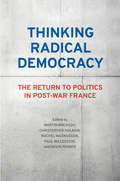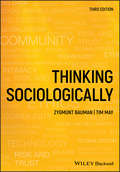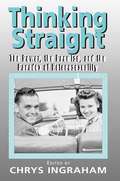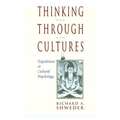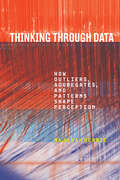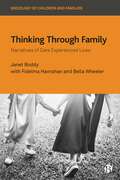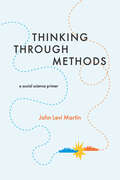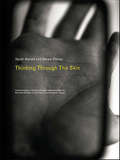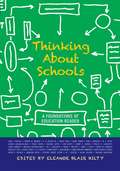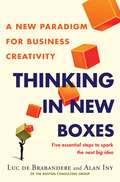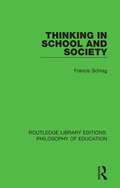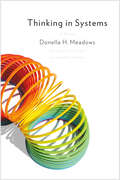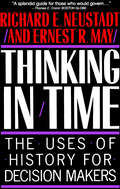- Table View
- List View
Thinking Queerly
by David Ross FryerQueer theory and the gay rights movement historically have been in tension, with the former critiquing precisely the identity politics on which the latter relies. Yet neither queer theory, in its predominately poststructuralist form, nor the gay rights movement, with its conservative "inclusionary" aspirations, has adequately addressed questions of identity or the political struggles against normativity that mark the lives of so many queer people. Taking on issues of race, sex, gender, and what he calls "the ethics of identity," Fryer offers a new take on queer theory-one rooted in phenomenology rather than poststructuralism-that seeks to put postnormative thinking at its center. This provocative book gives us a glimpse of what "thinking queer" can look like in our "posthumanist age."
Thinking Radical Democracy
by Martin Breaugh Christopher Holman Rachel Magnusson Devin Penner Paul MazzocchiThinking Radical Democracy is an introduction to nine key political thinkers who contributed to the emergence of radical democratic thought in post-war French political theory: Hannah Arendt, Maurice Merleau-Ponty, Pierre Clastres, Claude Lefort, Cornelius Castoriadis, Guy Debord, Jacques Rancière, Étienne Balibar, and Miguel Abensour.The essays in this collection connect these writers through their shared contribution to the idea that division and difference in politics can be perceived as productive, creative, and fundamentally democratic. The questions they raise regarding equality and emancipation in a democratic society will be of interest to those studying social and political thought or democratic activist movements like the Occupy movements and Idle No More.
Thinking Sociologically
by Zygmunt Bauman Tim MayWidely acclaimed insight on the human condition, updated to view modern issues through a sociological lens Now in its third edition, Thinking Sociologically continues to offer a stimulating exploration of the underlying assumptions and tacit expectations which structure our view of the world. This best-seller has been translated into 12 languages to bring key sociological concepts to students and general readers around the globe. The authors review recent developments in society and examine the applicability of sociology to everyday life. The world has changed a great deal since the second edition’s publication. Issues of climate change, sustainability, inequality, social justice, inclusion and the role of social media have risen to prominence, and we are collectively challenging our ways of thinking about intimacy, community, consumption, ethics, social identity, and more. This new third edition has been revised to reflect these and other transformations in our lives, helping us to think sociologically about the consequences of these burgeoning issues, how we organize our societies, understand ourselves and lead our lives. This dynamic book: Applies sociology to everyday life in the context of current issues Contains contributions from major theorists that introduce central sociological concepts with modern relevance Features a highly engaging and stimulating style that promotes critical thought and independent study Written for undergraduates, postgraduates, practicing sociologists and social scientists, this book also holds a broad appeal to a general audience. The third edition of Thinking Sociologically offers a compelling survey of sociological issues, recent changes in society and their influence on our day-to-day lives and identities. Learn more about Thinking Sociologically in co-author Tim May's recent piece for the British Sociological Association.
Thinking Straight: The Power, Promise and Paradox of Heterosexuality
by Chrys IngrahamThis collection of original essays will unravel the current heterosexual scene in two parts: one on rights and privileges, the other on popular culture. Topics covered include weddings, proms, citizenship, marriage penalties, cartoons, mermaids and myth.
Thinking Through Climate Change: A Philosophy of Energy in the Anthropocene (Palgrave Studies in the Future of Humanity and its Successors)
by Adam BriggleIn this creative exploration of climate change and the big questions confronting our high-energy civilization, Adam Briggle connects the history of philosophy with current events to shed light on the Anthropocene (the age of humanity). Briggle offers a framework to help us understand the many perspectives and policies on climate change. He does so through the idea that energy is a paradox: changing sameness. From this perennial philosophical mystery, he argues that a high-energy civilization is bound to create more and more paradoxes. These paradoxes run like fissures through our orthodox picture of energy as the capacity to do work and control fate. Climate change is the accumulation of these fissures and the question is whether we can sustain technoscientific control and economic growth. It may be that our world is about change radically, imploring us to start thinking heterodox thoughts.
Thinking Through Crisis: Improving Teamwork and Leadership in High-risk Fields
by Amy L. FraherBridging the gap between theory and practice, this strikingly original analysis of the complex dynamics of high-risk fields demonstrates that teamwork is more important than technical prowess in averting disasters. Thinking Through Crisis narrates critical incidents from initiation to resolution in five elegantly constructed case studies: the USS Greeneville collision, the Hillsborough football crush, the American Airlines flight 587 in-flight break-up, the Bristol Royal Infirmary pediatric fatalities and the US Airways flight 1549 Hudson River landing. Drawing on a variety of theoretical and real-world perspectives, this vivid, well-documented book provides innovative ways to understand risk management, develop new models of crisis decision making, enhance socially responsible leadership and encourage deep questioning of the behavior of individuals and groups in complex systems. Its insights will resonate with professionals in a wide range of fields and with a general audience interested in understanding crises in complex systems.
Thinking Through Cultures: Expeditions in Cultural Psychology
by Richard A. ShwederIn this book, Shweder calls an exploration of the human mind, and of one's own mind, by thinking through the ideas and practices of other peoples and their cultures. He examines evidence of cross-cultural similarities and differences in mind, self, emotion, and morality with special reference to the cultural psychology of a traditional Hindu temple town in India, where he has done considerable work in comparative anthropology.
Thinking Through Data: How Outliers, Aggregates, and Patterns Shape Perception (Sensing Media: Aesthetics, Philosophy, and Cultures of Media)
by Maja Bak HerrieWe encounter digital data processing on a range of platforms and in a multitude of contexts today: in the predictive algorithms of the financial sector, in drones, insurance, and risk management, in smart cities, biometrics, medicine, and more. This fascinating book explores the historical context of the current data-driven paradigm and explains how elusive yet crucial statistical concepts such as outliers, aggregates, and patterns form how we sense and make sense of data. From the sixteenth century's embodied measurements of the foot, through the blurred facial features of L'Homme Moyen, to the image aggregates of today's security systems, the examples collected in this book illustrate the central role of aesthetics throughout the history of statistical knowledge production. Taking its point of departure in analyses and discussions of contemporary artistic experiments by Rossella Biscotti, Stéphanie Solinas, and Adam Broomberg and Oliver Chanarin, the book broadens our understanding of the structures of knowledge and methods in statistical computation beyond optimistic narratives of calculative power. Venturing out into the tails of the distributions—to the systemically overlooked and excluded—this book challenges us to embrace an alternative view of modern data processing.
Thinking Through Digital Media
by Dale Hudson Patricia R. ZimmermannThinking through Digital Media offers a means of conceptualizing digital media by looking at projects that think through digital media, migrating between documentary, experimental, narrative, animation, video game, and live performance. Hudson and Zimmermann analyze projects at the intersections of imbedded technologies, transitory micropublics, human-machine interface, and critical cartographies to forward a set of speculations about how things work together rather than what they represent. The book frames debates on participation/surveillance, outsourcing, global warming, migrations, GMOs, and war across some of the most dynamic, innovative sites for digital media, including Brazil, Canada, China, Germany, India, Indonesia, Italy, Kenya, Nigeria, Palestine, Saudi Arabia, Singapore, and the United States.
Thinking Through Dilemmas: Schemas, Frames, and Difficult Decisions (Routledge Advances in Sociology)
by Lawrence H. WilliamsDeparting from the sociological dual process model that divides thoughts into automatic and unconscious, or deliberate and conscious occurrences, this book draws on empirical cases to demonstrate the existence of “automatic deliberation.” Through research into the ways in which people address difficult subjects, such as death and dying, pedophilia, and career decision-making, the author sheds light on a mode of thinking which is both habitual and effortful, displaying a combination of habituated understandings and conscious deliberation. Advancing a blended view of cognition by which individuals draw on schemas and frames to think through complex topics, this volume will appeal to sociologists and psychologists with interests in cognition and the ways in which we make decisions.
Thinking Through Family: Narratives of Care Experienced Lives
by Janet BoddyUnderstanding what ‘family’ means – and how best to support families – depends on challenging politicized assumptions that frame ‘ordinary’ families in comparison to an imagined problematic ‘other’. Learning from the perspectives of people who were in care in childhood, this innovative book helps redefine the concept of family. Linking two longitudinal studies involving young adults in England, it reveals important new insights into the diverse and dynamic complexity of family lives, identities and practices in time – through childhood and beyond. Paving the way for future policy and practice, this book makes an important contribution to the theorization of family in the 21st century.
Thinking Through Methods: A Social Science Primer
by John Levi MartinSociological research is hard enough already—you don’t need to make it even harder by smashing about like a bull in a china shop, not knowing what you’re doing or where you’re heading. Or so says John Levi Martin in this witty, insightful, and desperately needed primer on how to practice rigorous social science. Thinking Through Methods focuses on the practical decisions that you will need to make as a researcher—where the data you are working with comes from and how that data relates to all the possible data you could have gathered. This is a user’s guide to sociological research, designed to be used at both the undergraduate and graduate level. Rather than offer mechanical rules and applications, Martin chooses instead to team up with the reader to think through and with methods. He acknowledges that we are human beings—and thus prone to the same cognitive limitations and distortions found in subjects—and proposes ways to compensate for these limitations. Martin also forcefully argues for principled symmetry, contending that bad ethics makes for bad research, and vice versa. Thinking Through Methods is a landmark work—one that students will turn to again and again throughout the course of their sociological research.
Thinking Through Statistics
by John Levi MartinSimply put, Thinking Through Statistics is a primer on how to maintain rigorous data standards in social science work, and one that makes a strong case for revising the way that we try to use statistics to support our theories. But don’t let that daunt you. With clever examples and witty takeaways, John Levi Martin proves himself to be a most affable tour guide through these scholarly waters. Martin argues that the task of social statistics isn't to estimate parameters, but to reject false theory. He illustrates common pitfalls that can keep researchers from doing just that using a combination of visualizations, re-analyses, and simulations. Thinking Through Statistics gives social science practitioners accessible insight into troves of wisdom that would normally have to be earned through arduous trial and error, and it does so with a lighthearted approach that ensures this field guide is anything but stodgy.
Thinking Through the Skin (Transformations)
by Sara Ahmed Jackie StaceyThis exciting collection of work from leading feminist scholars including Elspeth Probyn, Penelope Deutscher and Chantal Nadeau engages with and extends the growing feminist literature on lived and imagined embodiment and argues for consideration of the skin as a site where bodies take form - already written upon but open to endless re-inscription.Individual chapters consider such issues as the significance of piercing, tattooing and tanning, the assault of self harm upon the skin, the relation between body painting and the land among the indigenous people of Australia and the cultural economy of fur in Canada. Pierced, mutilated and marked, mortified and glorified, scarred by disease and stretched and enveloping the skin of another in pregnancy, skin is seen here as both a boundary and a point of connection - the place where one touches and is touched by others; both the most private of experiences and the most public marker of a raced, sexed and national history.
Thinking Together: An E-Mail Exchange and All That Jazz
by Howard S. Becker Robert R. Faulkner Larry Gross Arlene Luck Franck Leibovici Dianne HagamanFaulkner and Becker, sociologists and experienced musicians, wrote a book about their musical experiences--Do You Know? The Jazz Repertoire in Action--describing how musicians who didn't know each other could perform competently and interestingly without rehearsing, or playing from written music. When they wrote it, they lived at opposite ends of the country: Faulkner in Massachusetts, Becker in San Francisco. Instead of sitting around talking about their ideas, they wrote e-mails. So every step of their thinking, false steps as well as ideas that worked, existed in written form.When conceptual artist and poet Franck Leibovici asked them to contribute something that showed the "form of life" that supported their work, they collaborated with Dianne Hagaman to put the correspondence in order, which Liebovici exhibited and now appears as an e-book (which allows linking to available performances of the tunes they discussed).It's one of the most revealing records of a scientific collaboration ever made public, and an intimate picture of the creative process.Collective creativity--making sparks of originality produce something more than a glint in someone's eye--intrigues sociologists, people who study communication and theorists of business organization. The collective part of that process, turning an idea into a finished product, is even more complicated, and Thinking Together readers can watch the authors go through all the complications of working together to make the final result happen.Becker played piano in Chicago and Kansas City and taught sociology at Northwestern University. Among his books are Art Worlds and Writing for Social Scientists.Faulkner played trumpet in Los Angeles, got a PhD in sociology from UCLA, then taught at the University of Rochester and the University of Massachusetts (playing professionally in those places too). He is author of two books about the movie business, Hollywood Studio Musicians and Music on Demand: Composers and Careers in the Hollywood Film Industry.
Thinking about Belonging in Youth Studies (Studies in Childhood and Youth)
by Johanna Wyn Anita Harris Hernan CuervoThis book takes a global perspective to address the concept of belonging in youth studies, interrogating its emergence as a reoccurring theme in the literature and elucidating its benefits and shortcomings. While belonging offers new alignments across previously divergent approaches to youth studies, its pervasiveness in the field has led to criticism that it means both everything and nothing and thus requires deeper analysis to be of enduring value. The authors do this work to provide an accessible, scholarly account of how youth studies uses belonging by focusing on transitions, participation, citizenship and mobility to address its theoretical and historical underpinnings and its prevalence in youth policy and research.
Thinking about Schools
by Eleanor Blair HiltyHilty collects dozens of classic and contemporary essays designed to engage students and encourage critical thinking and discussion on topics relating to schools and education. The book is divided into five parts. Part I discusses the aims and purposes of education, part II the content of the curriculum, part III the roles and responsibilities of teachers, part IV the roles and responsibilities of students, and part V the issues that impact 21st century schools. Each part includes an introduction, discussion questions, a guide to further reading and related resources. Annotation ©2011 Book News, Inc. , Portland, OR (booknews. com)
Thinking about Schools
by Eleanor Blair HiltyDesigned specifically for students with little or no education background, Thinking About Schools is an essential collection of classic and contemporary readings that provides a complete, balanced overview of educational foundations. Anchored in classic scholarship from the 1960s to today, this book also incorporates a number of thought-provoking popular essays that will engage students and encourage critical thinking about vital issues concerning the purpose of education, curriculum content, the roles and responsibilities of students and teachers, and new directions for education in the twenty-first century. In addition to selecting each reading for its impact and accessibility, editor Eleanor Blair Hilty further promotes student comprehension by including introductions, discussion questions, guides to further reading, and related resources for each of the five parts.
Thinking about Water in Uncertain Times: State, People and Conflicts
by Sailen Routray N. Shantha MohanThis book is a collection of six essays by the authors on conflicts around water. It draws on their work and experiences with the Water Programme at the National Institute of Advanced Studies (NIAS), Bangalore, India. Among other topics, the essays in this book also discuss interstate transboundary water sharing and conflict resolution, the formation of zonal water partnerships (ZWPs), and the development of interdisciplinary knowledge in relation to transboundary water sharing.The aim of this work is to develop context-specific multidisciplinary knowledge on social, economic, cultural, legal and political aspects of water sharing and conflicts.Print edition not for sale in South Asia (India, Sri Lanka, Nepal, Bangladesh, Pakistan or Bhutan)
Thinking in New Boxes: A New Paradigm for Business Creativity
by Alan Iny Luc De BrabandereWhen BIC, manufacturer of disposable ballpoint pens, wanted to grow, it looked for an idea beyond introducing new sizes and ink colors. Someone suggested lighters. LIGHTERS? With an idea that seemed crazy at first, that bright executive, instead of seeing BIC as a pen company--a business in the PEN "box"--figured out that there was growth to be found in the DISPOSABLE "box." And he was right. Now there are disposable BIC lighters, razors, even phones. The company opened its door to a host of opportunities. IT INVENTED A NEW BOX. Your business can, too. And simply thinking "out of the box" is not the answer. True ingenuity needs structure, hard analysis, and bold brainstorming. It needs to start THINKING IN NEW BOXES --a revolutionary process for sustainable creativity from two strategic innovation experts from The Boston Consulting Group (BCG). To make sense of the world, we all rely on assumptions, on models--on what Luc de Brabandere and Alan Iny call "boxes." If we are unaware of our boxes, they can blind us to risks and opportunities. This innovative book challenges everything you thought you knew about business creativity by breaking creativity down into five steps: * Doubt everything. Challenge your current perspectives. * Probe the possible. Explore options around you. * Diverge. Generate many new and exciting ideas, even if they seem absurd. * Converge. Evaluate and select the ideas that will drive breakthrough results. * Reevaluate. Relentlessly. No idea is a good idea forever. And did we mention Reevaluate? Relentlessly. Creativity is paramount if you are to thrive in a time of accelerating change. Replete with practical and potent creativity tools, and featuring fascinating case studies from BIC to Ford to Trader Joe's, Thinking in New Boxes will help you and your company overcome missed opportunities and stay ahead of the curve. This book isn't a simpleminded checklist. This is Thinking in New Boxes. And it will be fun. (We promise.) Advance praise for Thinking in New Boxes "Thinking in New Boxes is a five-step guide that leverages the authors' deep understanding of human nature to enable readers to overcome their limitations and both imagine and create their own futures. This book is a must-read for people living and working in today's competitive environment."--Ray O. Johnson, Ph.D., chief technology officer, Lockheed Martin "Thinking In New Boxes discusses what I believe to be one of the fundamental shifts all companies/brands need to be thinking about: how to think creatively, in order to innovate and differentiate our brands. We need to thrive and lead in a world of accelerating change and this book challenges us to even greater creativity in our thinking. One of the best business books I've read in a long time."--Jennifer Fox, CEO, Fairmont Hotels & Resorts "As impressive as teaching new tricks to old dogs, Thinking in New Boxes is both inspirational and practical--a comprehensive, step-by-step guide to sharpening one's wits in order to harness creativity in the workplace."--Peter Gelb, general manager, Metropolitan Opera
Thinking in Place: Art, Action, and Cultural Production
by Carol BeckerCarol Becker, preeminent arts educator and contributor to leading art magazines, offers a beautifully poignant meditation on the role of place in artistic creativity. She focuses on place as a historical, physical entity and a conceptual site where ideas come into meaning. The book explores places from the coal-mining towns of western Pennsylvania, to the Birla House where Gandhi was shot, to the sinking city of Venice. A cross between theory, memoir, and history, her writing creates the experiential effect of being in specific places as well as imagining the evolution of ideas as they are manifested in museums and often become agents for social change.
Thinking in Promises: Designing Systems for Cooperation
by Mark BurgessImagine a set of simple principles that could help you to understand how parts combine to become a whole, and how each part sees the whole from its own perspective. If such principles were any good, it shouldn’t matter whether we’re talking about humans on a team, birds in a flock, computers in a datacenter, or cogs in a Swiss watch. A theory of cooperation ought to be pretty universal, so we should be able to apply it both to technology and to the workplace.Such principles are the subject of Promise Theory, and the focus of this insightful book. The goal of Promise Theory is to reveal the behavior of a whole from the sum of its parts, taking the viewpoint of the parts rather than the whole. In other words, it is a bottom-up, constructionist view of the world. Start Thinking in Promises and find out why this discipline works for documenting system behaviors from the bottom-up.
Thinking in School and Society (Routledge Library Editions: Philosophy of Education #16)
by Francis SchragIn this book, first published in 1988, the author integrates relevant ideas from philosophy, psychology, sociology, economics and political science to provide a comprehensive analysis of the problem of education for thinking. Professor Schrag takes account of the classroom as well as the larger society, and includes practical recommendations for creating new settings designed to enhance students’ thoughtfulness.
Thinking in Systems: International Bestseller
by Donella MeadowsThe classic book on systems thinking—with more than half a million copies sold worldwide!&“This is a fabulous book… This book opened my mind and reshaped the way I think about investing.&”—Forbes&“A modern classic&”—The New YorkerIn the years following her role as the lead author of the international bestseller, Limits to Growth—the first book to show the consequences of unchecked growth on a finite planet—Donella Meadows remained a pioneer of environmental and social analysis until her untimely death in 2001.Thinking in Systems is a concise and crucial book offering insight for problem solving on scales ranging from the personal to the global. Edited by the Sustainability Institute&’s Diana Wright, this essential primer brings systems thinking out of the realm of computers and equations and into the tangible world, showing readers how to develop the systems-thinking skills that thought leaders across the globe consider critical for 21st-century life.Some of the biggest problems facing the world—war, hunger, poverty, and environmental degradation—are essentially system failures. They cannot be solved by fixing one piece in isolation from the others, because even seemingly minor details have enormous power to undermine the best efforts of too-narrow thinking.While readers will learn the conceptual tools and methods of systems thinking, the heart of the book is grander than methodology. Donella Meadows was known as much for nurturing positive outcomes as she was for delving into the science behind global dilemmas. She reminds readers to pay attention to what is important, not just what is quantifiable, to stay humble, and to stay a learner.In a world growing ever more complicated, crowded, and interdependent, Thinking in Systems helps readers avoid confusion and helplessness, the first step toward finding proactive and effective solutions.&“Thinking in Systems is required reading for anyone hoping to run a successful company, community, or country. Learning how to think in systems is now part of change-agent literacy. And this is the best book of its kind.&”—Hunter Lovins
Thinking in Time: The Uses of History for Decision Makers
by Richard E. NeustadtHow to use history to make correct decisions, when it's all too easy to use it to justify bad decisions.

